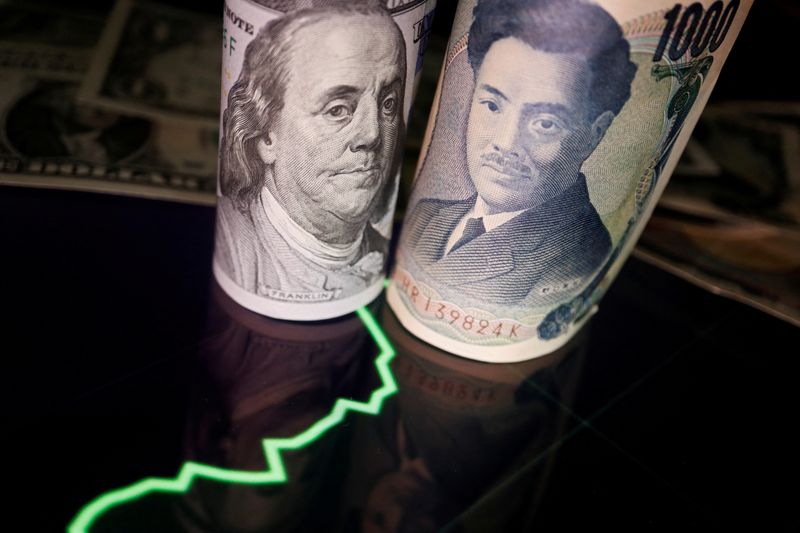Forex
Strengthening dollar puts yen within striking distance of 150


© Reuters. FILE PHOTO: Japanese yen and U.S. dollar banknotes are seen with a currency exchange rate graph in this illustration picture taken June 16, 2022. REUTERS/Florence Lo/Illustration/File Photo
By Samuel Indyk and Rae Wee
LONDON (Reuters) – The dollar was in the ascendant on Monday on the prospects that U.S. interest rates would stay higher for longer, while the yen slid towards 150 per dollar and near a one-year low, putting traders on watch for intervention from Japanese authorities.
The yen eased to 149.83 per dollar, its weakest in more than 11 months, moving ever closer to the 150 mark that some traders believe could prompt intervention by Tokyo to support the currency.
“For the yen to sustainably turn, the Bank of Japan needs to move away from its very loose monetary policy,” said Dane Cekov, senior FX strategist at Nordea.
“If the yen breaks 150 per dollar, which I think is likely, and verbal intervention is not followed by action then we could see dollar-yen at 155.”
A summary of opinions at the Bank of Japan’s September meeting, out on Monday, showed policymakers discussed various factors that must be taken into account when exiting ultra-loose policy, while Finance Minister Shunichi Suzuki said they were closely watching FX moves with a “strong sense of urgency”.
In the broader currency market, sterling was last 0.4% lower at $1.2158, having slid nearly 4% against the dollar in the third quarter.
The euro was down 0.4% at $1.0535, after ending the previous quarter with a 3% fall, its worst performance in a year, as the relative divergence of the U.S. and European economies plays out in the currency market.
Manufacturing activity in the euro area and Britain remained in a deep downturn in September, final data showed on Monday.
The edged back towards its recent 10-month high of 106.84 and was last at 106.51, after clocking its best quarterly performance in a year thanks to persistently hawkish Federal Reserve rhetoric and a surge in U.S. treasury yields.
The U.S. 10-year yield was up another 6 basis points on Monday at 4.6289%, close to a 17-year peak of 4.688% reached last week.
“I’d rather be in dollars at the moment than euros or pounds or others,” said Jarrod Kerr, chief economist at Kiwibank. “I think the dollar will find a bit more support.”
The U.S. Congress late on Saturday passed a stop-gap funding bill with overwhelming Democratic support in a bid to avoid the federal government’s fourth partial shutdown in a decade, although analysts played down any long-term market impact.
“Historically, shutdowns are noise,” Nordea’s Cekov said. “They don’t really make a dent for markets or the economy.”
Elsewhere, the Australian dollar slid 0.6% to $0.6395, while the New Zealand dollar edged 0.4% lower to $0.5972, as traders looked ahead to rate decisions from their respective central banks this week.
In cryptocurrencies, bitcoin was trading above $28,000 for the first time since August after a weekend rally took the cryptocurrency as high as $28,492, its highest level since Aug. 17.

 Forex3 years ago
Forex3 years agoForex Today: the dollar is gaining strength amid gloomy sentiment at the start of the Fed’s week

 Forex3 years ago
Forex3 years agoUnbiased review of Pocket Option broker

 Forex3 years ago
Forex3 years agoDollar to pound sterling exchange rate today: Pound plummeted to its lowest since 1985

 Forex3 years ago
Forex3 years agoHow is the Australian dollar doing today?

 Cryptocurrency3 years ago
Cryptocurrency3 years agoWhat happened in the crypto market – current events today

 World3 years ago
World3 years agoWhy are modern video games an art form?

 Commodities3 years ago
Commodities3 years agoCopper continues to fall in price on expectations of lower demand in China

 Economy3 years ago
Economy3 years agoCrude oil tankers double in price due to EU anti-Russian sanctions























